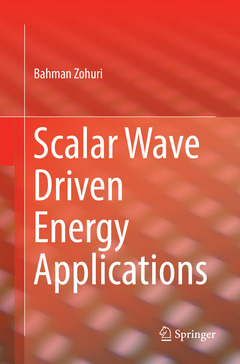Description
Scalar Wave Driven Energy Applications, 1st ed. 2019
Author: Zohuri Bahman
Language: English
Publication date: 01-2019
Support: Print on demand
Out of Print
Publication date: 09-2018
Support: Print on demand
Out of Print
Description
/li>Contents
/li>Biography
/li>Comment
/li>
This book discusses innovations in the field of Directed Energy (DE) and presents new technologies and innovative approaches for use in energy production for possible Underwater Communication, Directed Energy Weapons Applications and at lower wave energy for Medical Applications as well. In-depth chapters explore the challenges related to the study of energy produced from Scalar Longitudinal Wave (SLW). Topics related to Scalar Longitudinal Waves (SLW) and their various applications in the energy, medical, and military sector are discussed along with principles of Quantum Electrodynamics (QED) and theory, weapon applications of SLW, as well as SLW driven propulsion via an all-electronic engine, and for underwater communications. Scalar Wave Driven Energy Applications offers a unique solution for students, researchers, and engineers seeking a viable alternative to traditional approaches for energy production.
Dr. Bahman Zohuri currently works for Galaxy Advanced Engineering, Inc., a consulting firm that he started in 1991 when he left both the semiconductor and defense industries after many years working as a chief scientist. After graduating from the University of Illinois in the field of physics, applied mathematics, then he went to the University of New Mexico, where he studied nuclear engineering and mechanical engineering. He joined Westinghouse Electric Corporation, where he performed thermal hydraulic analysis and studied natural circulation in an inherent shutdown, heat removal system (ISHRS) in the core of a liquid metal fast breeder reactor (LMFBR) as a secondary fully inherent shutdown system for secondary loop heat exchange. All these designs were used in nuclear safety and reliability engineering for a sel4-actuated shutdown system. He designed a mercury heat pipe and electromagnetic pumps for large pool concepts of a LMFBR for heat rejection purposes for this reactor around 1978, when he received a patent for it. He was subsequently transferred to the defense division of Westinghouse, where he oversaw dynamic analysis and methods of launching and controlling MX missiles from canisters. The results were applied to MX launch seal performance and muzzle blast phenomena analysis (i.e., missile vibration and hydrodynamic shock formation). Dr. Zohuri was also involved in analytical calculations and computations in the study of nonlinear ion waves in rarefying plasma. The results were applied to the propagation of so-called soliton waves and the resulting charge collector traces in the rarefaction characterization of the corona of laser-irradiated target pellets. As part of his graduate research work at Argonne National Laboratory, he performed computations and programming of multi-exchange integrals in surface physics and solid-state physics. He earned various patents in areas such as diffusion processes and diffusion furnace design while working as a
Offers an innovative and unique solution to the challenge of finding new and innovative sources of energy production
Focuses on real world applications of SLW in the energy, medical, and military sectors
These books may interest you

Cosmology in Scalar-Tensor Gravity 158.24 €



